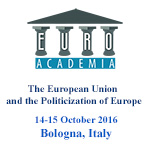Euroacademia Conferences
 Europe Inside-Out: Europe and Europeanness Exposed to Plural Observers (9th Edition) April 24 - 25, 2020
Europe Inside-Out: Europe and Europeanness Exposed to Plural Observers (9th Edition) April 24 - 25, 2020 Identities and Identifications: Politicized Uses of Collective Identities (9th Edition) June 12 - 13, 2020
Identities and Identifications: Politicized Uses of Collective Identities (9th Edition) June 12 - 13, 2020 8th Forum of Critical Studies: Asking Big Questions Again January 24 - 25, 2020
8th Forum of Critical Studies: Asking Big Questions Again January 24 - 25, 2020 Re-Inventing Eastern Europe (7th Edition) December 13 - 14, 2019
Re-Inventing Eastern Europe (7th Edition) December 13 - 14, 2019 The European Union and the Politicization of Europe (8th Edition) October 25 - 26, 2019
The European Union and the Politicization of Europe (8th Edition) October 25 - 26, 2019 Identities and Identifications: Politicized Uses of Collective Identities (8th Edition) June 28 - 29, 2019
Identities and Identifications: Politicized Uses of Collective Identities (8th Edition) June 28 - 29, 2019 The European Union and the Politicization of Europe (7th Edition) January 25 - 26, 2019
The European Union and the Politicization of Europe (7th Edition) January 25 - 26, 2019 7th Forum of Critical Studies: Asking Big Questions Again November 23 - 24, 2018
7th Forum of Critical Studies: Asking Big Questions Again November 23 - 24, 2018 Europe Inside-Out: Europe and Europeanness Exposed to Plural Observers (8th Edition) September 28 - 30, 2018
Europe Inside-Out: Europe and Europeanness Exposed to Plural Observers (8th Edition) September 28 - 30, 2018 Identities and Identifications: Politicized Uses of Collective Identities (7th Edition) June 14 - 15, 2018
Identities and Identifications: Politicized Uses of Collective Identities (7th Edition) June 14 - 15, 2018
Theorizing European Disintegration in Times of Complexity
-
-

-
Presentation speakers
- Senka Neuman Stanivukovic, Department of International Relations and International Organization, University of Groningen / Euroculture, The Netherlands
Abstract:
This paper adds to a growing discussion on the need to explain and theorize European disintegration (Schmitter; 2012; Vollard, 2014; Auer, 2015; Krastev, 2015). In its central argument, the paper establishes that problematization of European disintegration should take place outside of the realm of traditional EU theorizing. Whereas the mainstream scholarship attempts to reevaluate ability of the existing integration theories to make sense of events such as the so-called euro-zone/solidarity/migration/identity/etc. crises, this paper takes an opposite turn. Events that have marked contemporary European political landscape are adopted to critically rethink how Europe is imagined within the European integration theorizing. Whereas Schmitter for instance adopts the neo-institutional concepts of spill-over and spill-back to classify political processes in terms of furthering supranational institutions (integration) or reversing them (disintegration), this paper sees the very terms integration and disintegration to be constrained by the presupposition of the existence of a European telos and the consequent definition of integration as a liner development towards that telos. In response, the paper draws from Latourian political philosophy – Latour’s redefinition of the political as a mode – to challenge the existing nature of the beast debates within EU scholarship. It develops on Walters’ 2002/2004 call for the scholarship to rethinking European integration by examining mundane acts/procedures that make/constitute Europe as a political and regulable space (84). Walters’ adopts Latour’s power of association to explain not “what Europe” but “how Europe” is made governable (94). Analytical focus is consequently placed on heterogeneous assemblages and everyday enactments of these assemblages. This paper goes further in adopting Latour’s discussion of the “political” to shed a different light on the events that are increasingly classified as “the crisis” or disintegration. The paper makes three central claims. First, the European subject is polymorphous. Europe is realized in multitudinal assemblages and practices. Second, European integration is essentially relational rather than unidirectional. Third, the European subject is both symbolic and material. Europe is enacted by speeches, monuments, flags but also documents, technologies, financial instrument, architectural artefacts, or agricultural land. In the context of redefining European integration as multitudinal, disintegration is debunked as a useful concept and events widely referred to as disintegration are consequently re-examined via the actor-network theory.
-
Related Presentations

Fortress Europe: The Dangers of Democratic Insecurities
- Monika Gabriela Bartoszewicz

Diplomatic Instruments: U.S. Symphony Orchestras And The Cold War
- Jonathan Rosenberg

Bologna’s Iconography. The Representation of the City in the Paintings of Pinacoteca Nazionale
- Denise Tamborrino

The International Activity of Cultural Institutes
- Gretchen Simms

Behind the Synthetic Curtain: The Politics of Plastic in Czechoslovakia
- Roksana Filipowska













